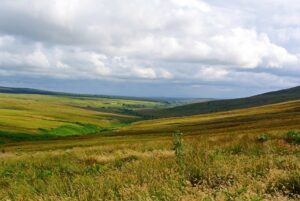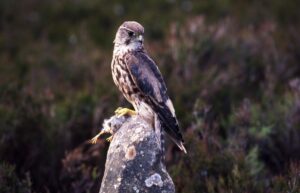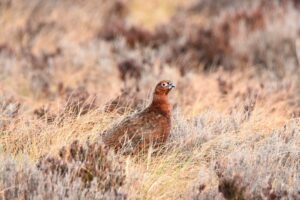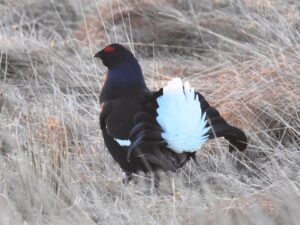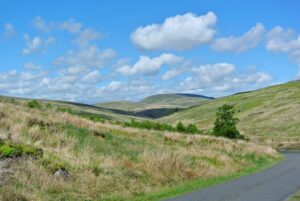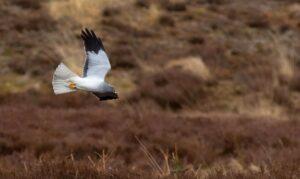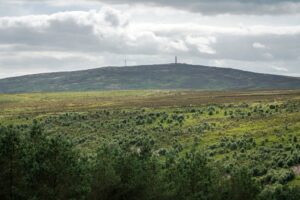This Guest Article for REVITALIZATION is by Kevin Cumming.
Imagine a place where hen harriers roam above the dramatic hills of a former grouse moor – sky dancing alongside the unmistakable call of the curlew.
Flowing through this moor might be a river with a hidden world beneath its surface – home to playful otters and bobbing dippers. Native woodlands are thriving and creating a mosaic of wonderful habitats.
Now consider the benefits if such a place could be protected and taken into community ownership by the people who live and work there.
No need to stretch your imagination too far – because Langholm Moor in southern Scotland is such a place. And there is now a unique opportunity for this precious land to be taken into the care and ownership of the local population through a pioneering community buyout.
Make no mistake: this is a big landscape scale project – pushing the boundaries of community regeneration and ecological restoration.
Southern Scotland’s biggest community land buyout
I work for the Langholm Initiative charity (langholminitiative.org.uk), based in Langholm in Dumfries and Galloway. Formed in 1994 as one of south Scotland’s earliest development trusts, our charity facilitates projects that make a lasting difference to the local area and people.
For the past year, I’ve been leading a local working group investigating community ownership of nearly 10,500 acres – about 5,600 football pitches – of land close to Langholm for positive climate action, community regeneration, nature restoration, and wildlife conservation.
In these difficult times, our community buyout is a project of vision and hope, and a project for our future.
The robust plans put together by Langholm’s community have the environment and climate action at their heart. In May 2020, we launched our Langholm Moor Crowdfunder. With the public’s help we will be able to make this vision a reality.
The significance of this buyout project can’t be overstated. It addresses so many of the questions we face – here in the UK, and worldwide.
The climate emergency is the biggest long-term threat facing humanity. Tackling this is going to take landscape-scale change to reverse decades of mistreatment of our natural world.
By taking Langholm Moor under local community ownership, we want to demonstrate that individuals coming together for a common purpose can do something truly amazing.
Why Langholm?
Langholm was once a booming centre for the textile industry. Most local people would finish school and instantly find local employment in the mills. Speak to people here and they’ll tell you of days when you could walk out of a job in the morning and into another by the afternoon.
Sadly these days have gone. Over the last 20 years there has been a rapid decline in the industry.
In April 2020, Langholm’s last mill announced its likely closure. Langholm now faces the same problems as many other rural areas in Scotland – loss of industry, youth migration, and an aging population.
Something has to be done to change the fortunes of this once thriving community.
Langholm Moor has huge cultural and natural heritage. People here are immensely passionate about the land they believe to be theirs, and have marked the boundaries of the common land for over 250 years. This tradition still goes on today with a spectacular annual event – the Langholm Common Riding.
The national and international importance of the natural heritage on this land is recognised by large parts of it being designated as a Site of Special Scientific Interest and a Special Protection Area (for Hen Harriers).
Langholm Moor has been the site of two scientific studies regarding land management for driven grouse shooting. The latest of these – the Langholm Moor Demonstration Project – produced its final report last year. Its key finding was clear: driven grouse shooting was no longer economically sustainable on Langholm Moor.
After the study’s conclusion, the landowner – Buccleuch Estates – announced its decision to sell the land and it hoped to do so quite quickly. If the people of Langholm were to have a say in how their moor would be managed they would have to act promptly.
The clock started ticking. The question facing us was “what could you do with a former grouse moor?”
Creating a vast nature reserve
The project we have developed in close consultation with the community covers a range of subjects, and aims to improve our future environmentally and economically.
It’s about undertaking climate action, wildlife conservation, nature restoration and community regeneration – all built around a central goal: creating the Tarras Valley Nature Reserve.
On this land, we will restore peatland, create new native woodland, and regenerate ancient woodland. We will protect and enhance the remarkable flora and fauna that lives there.
Repairing damage to our internationally important peatlands will improve carbon storage. Creating 500 acres of new native woodlands will provide new habitat, offer amenity use and sequester carbon dioxide from the atmosphere. Ancient woodland regeneration along the Tarras Water will help provide a mosaic of habitats.
We will investigate sustainable and responsible outdoor tourism. I’ve travelled all over Scotland wildlife watching, and the experiences of Langholm Moor are unique and spectacular.
In one day, I can be treated to the spectacular sky dancing of courting hen harriers, witness the silent hunt of a short eared owl, or be mesmerised by the lekking of black grouse. I can be thrilled by the chase of merlin hunting a meadow pipit, smile as newly fledged dippers come to terms with life on the Tarras Water, and laugh at the antics of wild goat kids.
This is a special place – a hidden gem in the south of Scotland.
Sustainability
At the beginning of this project, we raised enough money for intensive investigations into the viability of community ownership. Many people kindly donated to our first crowdfunder to help with this.
Our study found that community ownership can be financially viable, and can run into a modest surplus right away. The main sources of revenue come from an existing commercial forestry plantation, rent from leased residential properties, agriculture and other tenancies.
By including a small area of land south of Langholm Moor and close to Langholm town, we have given ourselves options to undertake some sustainable development.
This includes the potential for appropriate small-scale renewable energy (a single small turbine and a single small solar farm) and the development of a small eco-campsite.
We will also investigate repurposing disused and dilapidated steadings for either small-scale housing or modern business units – both of which are badly needed in Langholm, where there have only been six new houses in the past 30 years.
The vast majority of the land will be used to create the Tarras Valley Nature Reserve.
However, these developments in the long term will allow us to continue to promote positive climate action, while acting as a catalyst for rural community regeneration.
Conservation and development are often seen as opposing forces – because in many places, development has been carried out at the expense of the natural environment. If we continue exploiting our planet, it will no longer be able to sustain us. This is one of the main reasons why our project is so important: we will demonstrate that it is possible to deliver ecological restoration alongside the regeneration of a community.
Impacts
One of the project’s most exciting elements – attracting widespread support – is the blueprint it could provide for other communities across the UK to improve their local environments in a post Covid-19 world.
In the long term, it could also indirectly address other topical land-use issues in the UK – including alternative uses for driven grouse moors, agriculture in a post-Brexit Britain, and the balance of land ownership in Scotland.
Our buyout project is supported by leading charities including Borders Forest Trust, John Muir Trust, Rewilding Britain, RSPB Scotland, Trees for Life, and The Woodland Trust.
Fundraising
After a joint valuation process, the total cost of purchasing 10,500 acres is just over £6 million.
Another option is for us to purchase around 5,200 acres of land, including six properties, jointly valued at £4.2 million. Discussions are ongoing.
The purchase – whether for 10,500 or 5,200 acres – would be South Scotland’s biggest community buyout in land value and area so far.
At the time of writing, we have raised £3.1 million. It’s an amazing result in just four months – but we have a way to go and more help is needed!
The John Muir Trust demonstrated faith in the project by kick-starting our fundraising drive in May 2020 with a £100,000 pledge.
In June, the Scottish Land Fund awarded us £1 million – a welcome big step forwards, but well below the £3 million we applied for and so leaving us with much to do.
In August, we received a major boost thanks to a £500,000 pledge from the Dunblane-based Carman Family Foundation.
We were able to share more good news in September, when South of Scotland Enterprise’s Board announced up to £1 million financial support. Later that month, the Garfield Weston Foundation – a family-founded grant-making Trust that supports charities across the UK – pledged £300,000 towards the buyout.
We’re continuing to seek other major funders, and are urging people who can help to get in touch.
Alongside these awards and another £80,000 in donations, our public crowdfunding campaign at www.gofundme.com/langholm-moor-buyout has so far received £130,000 towards its £200,000 target. Nearly 2,500 people have contributed. This year’s Hen Harrier Day – held online in August, and hosted by television presenters Chris Packham and Megan McCubbin – raised around £10,000.
It’s a big ask in these difficult times – but if readers are able to donate what they can to our crowdfunder, they will be contributing to one of the most forward thinking community plans of a generation, and providing hope for a better future for everyone.
We want to inspire communities around the globe to strive for a brighter tomorrow. If you can help us, we’ll be another step closer.
Help fund the Langholm Moor Community Buyout here.
Learn more about the area here.
About the author:
 Kevin Cumming works for charity The Langholm Initiative, based in the town of Langholm in Dumfries and Galloway, Scotland.
Kevin Cumming works for charity The Langholm Initiative, based in the town of Langholm in Dumfries and Galloway, Scotland.
He holds a BA (Hons) in Business Administration and an MSc in Conservation and Management of Protected Areas.
Currently Kevin manages the The Langholm Initiative’s Wild Eskdale project, which aims to provide outdoor education for the local community whilst promoting eco-tourism in the area.


